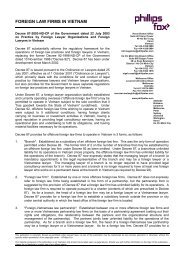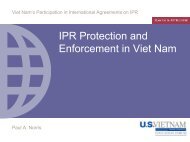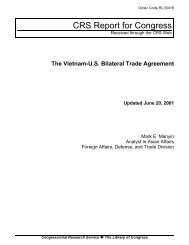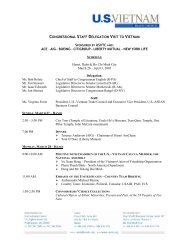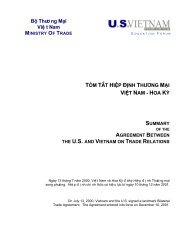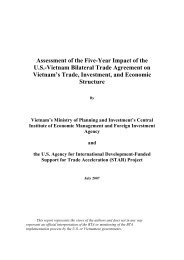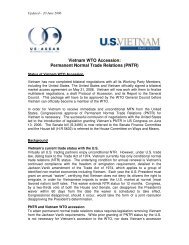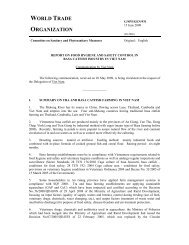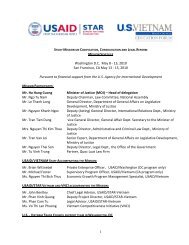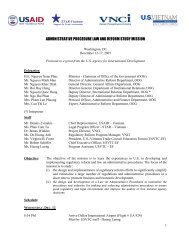Climate risks and adaptation in Asian coastal megacities: A synthesis
Climate risks and adaptation in Asian coastal megacities: A synthesis
Climate risks and adaptation in Asian coastal megacities: A synthesis
- No tags were found...
You also want an ePaper? Increase the reach of your titles
YUMPU automatically turns print PDFs into web optimized ePapers that Google loves.
sales loss data (categorized by type of economicactivity) by the number of affected build<strong>in</strong>gs <strong>in</strong> eacheconomic category, the study established the valueof <strong>in</strong>come losses to the commercial sector.Estimation of <strong>in</strong>come losses for poor <strong>and</strong>non-poor householdsHouseholds who work <strong>in</strong> flood-affected areas maylose <strong>in</strong>come dur<strong>in</strong>g the duration of the flood. Ageneral assumption made <strong>in</strong> the Bangkok case isthat salaried workers will not see <strong>in</strong>come lossesfrom floods. However, the <strong>in</strong>formal sector needsfurther account<strong>in</strong>g. In Bangkok, the low-<strong>in</strong>comehous<strong>in</strong>g developments, called condensed hous<strong>in</strong>g,<strong>in</strong> flooded areas are identified <strong>and</strong>—based onestimates of household size—the number of dailywage earners <strong>in</strong> this area is estimated. Then basedon the daily wage rate, the <strong>in</strong>come loss to poor <strong>and</strong>non-poor households is calculated.The Manila case study exam<strong>in</strong>es <strong>in</strong>come lossesto workers <strong>in</strong> the formal <strong>and</strong> <strong>in</strong>formal sectors. Becauseof lack of data on number of households, thecase study, like Bangkok, relied on the number ofbuild<strong>in</strong>gs affected by floods. Non-poor residentswere assumed to occupy residential build<strong>in</strong>gs at therate of 1.5 households per build<strong>in</strong>g. This allowed theManila study to estimate the total number of nonpoorresident households <strong>in</strong> flood-affected “formal”residential build<strong>in</strong>gs. The total number of affectedhouseholds was multiplied by the average <strong>in</strong>comeper household (based on government statistics) toobta<strong>in</strong> <strong>in</strong>come losses to the formal sector.To establish losses to the poor, the Manila studyfirst estimated the number of <strong>in</strong>formal structuresaffected by floods. It was assumed that at least twohouseholds live <strong>in</strong> each structure. Thus, the totalnumber of affected households was estimated.Aga<strong>in</strong>, us<strong>in</strong>g government statistics on the povertylevel per day of PHP 266 per household, the totallosses to the <strong>in</strong>formal sector was then established.Limited analysis of health impacts <strong>in</strong> thecity studiesAn important question concerns the impact of floodson public health. Each city is different <strong>and</strong> has healthimpact data based on previous experience with floods<strong>and</strong> expert advice. The ma<strong>in</strong> diseases associated withfloods are diarrhea, conjunctivitis, athlete’s foot,malaria, cholera, <strong>and</strong> typhoid. Ideally, we wouldrequire <strong>in</strong>formation on different outbreaks <strong>and</strong> costper episode per person for specific diseases <strong>in</strong> orderto value health impacts. However, this is difficultto obta<strong>in</strong> <strong>and</strong> some approximations are made. TheBangkok study makes an attempt to exam<strong>in</strong>e healthcosts associated with floods. In this case study, thenumber of <strong>in</strong>dividuals affected by floods is estimated<strong>and</strong> multiplied by the average per person health costsassociated with hospital admissions. This is clearly afirst approximation for what might be the real costson health from flood<strong>in</strong>g. However, lack of data, <strong>and</strong>difficulties <strong>in</strong> establish<strong>in</strong>g dose-response <strong>in</strong>formationrelated to different flood-related diseases, leadto this more simplistic analyses. The Manila studydoes not estimate the health costs from floods eventhough it makes an attempt to estimate some of thehealth impacts of flood<strong>in</strong>g. A more detailed analysisof health impacts needs to be carried out as a followupto this study.Assessment of Damage Costs<strong>in</strong> the HCMC StudyThe HCMC study used a macro-approach to assessdamage costs. Two different methods were used tocalculate the cost of climate change at an aggregatemacro-level: (1) cost estimates us<strong>in</strong>g l<strong>and</strong> values; <strong>and</strong>(2) cost estimates based on aggregate GDP loss. Themethodology applied <strong>in</strong> each of these approaches<strong>and</strong> the results obta<strong>in</strong>ed are described below.The l<strong>and</strong> value approachEconomically speak<strong>in</strong>g, the value of any asset isthe sum of the value it is expected to generate overtime, discounted to reflect people’s preferences forconsumption <strong>in</strong> the present. The same is true forl<strong>and</strong>. In pr<strong>in</strong>ciple, the current value of the l<strong>and</strong> stock<strong>in</strong> HCMC is the value of future production that canbe expected to be generated with this asset. L<strong>and</strong>value can be a particularly good guide to the cost ofclimate change as l<strong>and</strong> values capitalize most valuesthat need to be captured <strong>in</strong> any assessment of cost(such as roads, railways, water supply systems,Methodologies for Downscal<strong>in</strong>g, Hydrological Mapp<strong>in</strong>g, <strong>and</strong> Assess<strong>in</strong>g Damage Costs | 17



